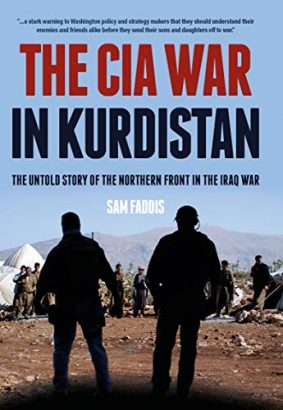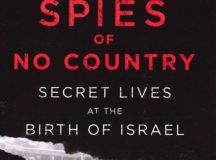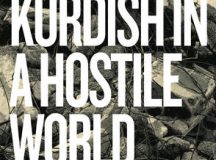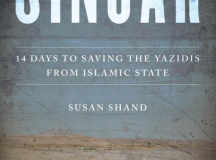Sam Faddis’s recent account of his time as a CIA operations officer in Iraq in the run-up to the 2003 Iraq War is a highly readable one replete with new details and lots of interesting tidbits about the CIA mission he oversaw in Iraqi Kurdistan. Faddis and his team were the first US personnel on the ground in Iraq before the 2003 war. They arrived in early 2002, initially anticipating a large-scale operation to topple Saddam to commence shortly thereafter. It was, of course, ultimately delayed until March 2003.
While sometimes scanty and vague on the details, since much of his team’s activities at that time undoubtedly remain classified, this book is, nevertheless, quite rich in previously unreported details about that mission as well as some frustrating recollections about the blunders the US made in Iraq before, during, and indeed after the invasion. Some interesting topics covered in the book include the complete failure of the US to enlist Turkey in helping establish a northern front in Kurdistan, as well as attempts by Turkish personnel to frustrate Faddis’s mission; the activities of the Al Qaeda linked Ansar al-Islam group, which had carved out a tyrannical Islamic State-like enclave in Iraqi Kurdistan; new insight into what US intelligence knew about Iraq’s Weapons of Mass Destruction (WMD) program; and, of course, examples of how the US fatally bungled what could have otherwise been a relatively seamless regime change in Baghdad.
The Turkish Factor
Faddis was tasked with preparing the ground for the US deployment to the semi-autonomous Kurdish region in the north, controlled since the end of the 1991 Persian Gulf War by forces of the friendly Kurdistan Democratic Party (KDP) group led by Masoud Barzani and the Patriotic Union of Kurdistan (PUK) group led by Jalal Talabani. The original plan was for the US Army to establish a large northern front in Kurdistan and advance southward into Saddam’s Iraq in cooperation with a simultaneous advance from the south in a classic pincer movement against Baghdad. However, from the get-go, this plan leaned heavily on the wholly unrealistic assumption that Turkey would willingly work with the Iraqi Kurds. Not only that, the US promised Barzani in advance that he could expect his peshmerga forces to be equipped with cutting-edge Javelin anti-tank missiles, which would have given them an edge over Iraqi armour. Faddis, who hadn’t been aware of this promise beforehand, asked his superiors in Washington what Ankara thought about this plan to arm the Kurds. Their dumbfounding response was that not only hadn’t they told Ankara, but they did not anticipate any problem. Gobsmacked, Faddis recalls: ‘All I could think was, Then you don’t know anything about the Turks.’ [Italics in the book] ‘We made the decision to invade Iraq,’ he added. ‘We promised the Kurds everything they could possibly want in the way of arms and support. Then, almost as an afterthought, we went to the Turks to fill them in.’
On the CIA team’s first deployment, Turkey’s condition for allowing them to enter Iraqi Kurdistan from Turkey was having a small team of Turkish military personnel accompany them every step of the way. According to Faddis, the Turks seemingly believed his team should have been completely subordinate to the Turkish General Staff. ‘Please do not do anything stupid,’ was the first thing the Turkish team leader told him when they first entered Kurdistan in 2002. Faddis doesn’t hide the utter disdain he felt over the arrogance of the Turks. The Turkish team deployed with them on their first mission were a pure hindrance. ‘Cut out of our operations, the Turks had nothing to do all day but sit around the house where we were all quartered,’ he recounts. ‘To pass the time they often sat outside the house dry firing their weapons at the Kurdish guards and laughing about how many Kurds they would kill before this was all over.’
While Faddis had little time for the ideology and methods of Turkey’s arch-enemy, the Kurdistan Workers’ Party (PKK), he also disdained Turkey’s treatment of its Kurdish minority in the country’s southeast. He recalled how he would tell Turkish personnel, ‘If I was born here, and you treated me the way you do them, I would be in those mountains carrying an AK-47 too.’
Reassuring the Kurds
‘We are going into Kurdistan to convince some very sceptical people, the Kurds, that we actually mean business this time,’ Faddis writes of their first deployment. ‘We are not just going to come and piss off Saddam and then walk away again leaving the men, women, and children of Kurdistan to face the consequences. We’re going to end this.’
However, he had no real means of reassuring Barzani that the US promise of Javelins, and cash for his forces, would ever see the light of day. All he could give the Kurdish leader was his personal word, reassuring him that he was familiar with the Kurds’ plight and how the US had left them to the mercy of Saddam in the past. ‘In Masoud’s place I think I would have demanded proof of our commitment before I ever even let us in the country,’ he writes. ‘It was to his credit he had let us come this far.’ Faddis’ team also took great care to balance their cooperation between the KDP and PUK, who had fought against each other in the Kurdish civil war in the 1990s, and ensure neither of them felt they weren’t on an ‘equal footing.’
In those days, the only physical US presence on the ground in Iraqi Kurdistan was Faddis and his team. The landlocked Kurds were in an extremely vulnerable position. Their lightly-armed Peshmerga faced several divisions of Iraqi tanks just behind the so-called Green Line that demarcated their self-governed region from Saddam’s Iraq. With no Turkish approval for any mass deployment of US troops to their enclave through Turkey, the Kurds would remain in that precarious situation for some time. A commander of Kurdish forces in Irbil, the capital of Iraqi Kurdistan, told what their plan, or lack thereof, was had the Iraqi Army attacked before the US military arrived was ‘run like hell.’
‘The Kurds would retreat into the mountains and bleed the Iraqi Army there,’ Faddis writes. ‘Irbil would be overrun, and we would suddenly find ourselves having to move quickly to stay one step ahead of Saddam’s killing machine.’
His team’s evacuation plan could have resulted in them having to flee through the rough mountainous Kurdish terrain, with few roads and minefields to boot, toward the Turkish border. However, it wasn’t even as simple as that. Turkish border guards could well have proven quite trigger happy if not informed in advance given their perennial conflict with the PKK, which often attacked across the border from mountain bases in that region. ‘For all these reasons,’ Faddis writes, ‘as well as what we assumed would be an almost total lack of cooperation from Ankara if we bugged out in a hurry, it was very possible that we would cross the mountains, escape Saddam’s clutches, and get shot by our own erstwhile NATO allies.’
At the same time, trade and smuggling continued between Kurdistan and Saddam’s Iraq. Faddis discovered this first hand in an amusing incident. He once bought a rug with Saddam’s face woven into it for his office in the team’s safe house so he could walk on the Iraqi dictator’s face anytime he was hosting Kurds. Other CIA personnel in the base inquired if they could get more of these rugs. The Kurds obliged, quickly finding and selling them several. When Faddis once remarked how surprised he was there were so many Saddam rugs in Kurdistan, a KDP officer revealed that it was, in fact, the Iraqis south of the Green Line who were making them for his team! ‘Yes, we order them,’ Faddis recalls that Kurdish officer telling him. ‘They make them. Nobody in Iraq wants a rug with a picture of Saddam on it except Americans.’
Upon leaving Kurdistan shortly after the US invasion toppled Saddam, the KDP’s powerful intelligence chief Masrour Barzani, who often did not see eye to eye with Faddis during the duration of his deployments, personally thanked him and his team for keeping their word and getting rid of Saddam and gifted them gold watches for their efforts.
The Ansar Enclave
Faddis and his team also investigated the small enclave Ansar had carved out in eastern Iraqi Kurdistan near Halabja. As with Islamic State a decade later, jihadists from other countries gathered in this terror mini-state. The Kurds suspected they were working on developing primitive cyanide-based chemical weapons and even biological weapons.
The US government eagerly wanted to link Ansar and Saddam since that would give them the ‘iron clad reason’ they needed to invade and topple his regime. Faddis repeatedly insisted that Washington’s desperate desire to find such a smoking gun would not interfere with the purpose of his team’s fact-finding mission. ‘We never found any evidence of collusion between Saddam and Al Qaeda or Ansar,’ he writes. ‘To the contrary, as one would expect, we found that Iraqi intelligence was very worried about what was happening in Ansar territory and had sent officers into the area to collect on that target just as we had.’
The CIA team sought to gather as much human intelligence from those inside the enclave as possible. In one alarming case, Faddis and his team debriefed a 16-year-old named Dogan, who Ansar had recruited as a suicide bomber to blow up a Kurdish police station. Dogan had sought to conceal his bulky vest under a large coat on a hot Kurdish summer day. When a Kurdish police officer stopped him and asked what was in his pocket, he answered that it was the switch for his explosive vest. ‘By all rights the police officer should have responded by shooting Dogan twice in the head,’ Faddis writes. ‘He did not. He told him to take his hand out of his pocket. Dogan did.’
The kid wasn’t ready to kill himself or anyone else. He explained how he had gotten to that grim point. Ansar would have paid his family, enabling them to feed his siblings. Also, none of them would be recruited for similar missions. ‘Dogan hated Ansar and everything they stood for,’ Faddis recalls. ‘He agreed to become a suicide bomber out of love for his family. He wasn’t a monster; he was a victim of a pestilence looking to infect yet another nation.’
Another incident recalled aptly demonstrated the resolve of Masrour. In the summer of 2002, Ansar kidnapped distant relatives of the Barzani’s and demanded ransom for their safe release. Masrour acted quickly and used his vast intelligence apparatus to locate several relatives of senior Ansar members living in territory controlled by the KDP and detain them. He then, in turn, signalled to Ansar there would be consequences if they harmed his relatives. Ansar complied and immediately released them.
‘There was no ambiguity in the message sent to Ansar,’ he writes. ‘None of the people Masrour had arrested were ever harmed. They were all released, having experienced nothing more than a few days’ confinement. Ansar understood implicitly, however, that the ending to the story would have been dramatically different had they not dropped their demands and complied with Masrour’s instructions.’
While PUK peshmerga, with American support, would later destroy the Ansar enclave during the invasion, Faddis was not approved to arrange such an attack in 2002 since the White House was worried that it would ‘spook Saddam and cause him to take preemptive action against the Kurds before we were ready.’ When the assault finally came, many of the Ansar leadership, seeing the build-up against their tiny terror enclave, fled to Iran, reorganised, regrouped, and fought the Americans later in the Iraq War.
Ever Elusive WMDs
The book includes some very noteworthy examples of how little the Americans knew about Iraqi WMDs and what they gradually learned about Saddam’s immense concealment efforts. For example, the CIA team wanted Washington to supply masks to the entire Kurdish population as a reassurance just in case Saddam again unleashed chemical bombardments on their cities. Washington did not oblige. However, one day his team got lucky. Baghdad had made a large purchase of gas masks for the army that they were smuggling from Turkey overland through Kurdistan. Faddis tipped off Masrour, who intercepted that transfer and confiscated the masks for the Kurds. Faddis reckons one reason Saddam’s regime had made that order for the army was part of an elaborate ruse to keep most Iraqis second-guessing and in the dark about the status of his chemicals weapons program. It was, he writes, ‘a perfect illustration of a key, and often misunderstood, point.’ Even though Saddam had relinquished all of his WMD stockpiles before the 2003 invasion, ‘he did not want his own people or his dangerous neighbours, the Iranians to know that.’ Consequently: ‘It was absolutely critical for Saddam to convince his own people that he was still hiding chemical weapons and pursuing other capabilities. At this Saddam was remarkably successful.’
In early 2003 a senior Iraqi general snuck across the Green Line to a Kurdish safe house, where Faddis and his team debriefed him. The general provided them with extensive information on the forces under his control. Regarding WMDs, while the Iraqi did not know much about the country’s biological or nuclear capabilities, aside from unverified rumours and speculation, he was absolutely positive Iraq still retained stockpiles of chemicals and was certain Saddam would resort to using them if attacked. The general had previously used such weapons during the Iran-Iraq War and insisted that absolutely nothing had changed since then, ‘Chemical arms were part of the standard repertoire of Iraqi operations.’
The general could even pinpoint the location of vast quantities of chemicals in storage bunkers on his base and accurately correlated intelligence Faddis had separately received about these locations. There was, however, a catch. When Faddis asked the simple question of when the last time the general had personally seen the weapons on the base, he ‘looked at me like I was crazy.’ Then, as if it should have been obvious, he said he had never actually been inside the bunkers because of his rank as a regular Iraqi Army officer, which forbade him from inspecting such unconventional weapons. They were strictly under the control of the Republican Guard, Saddam’s elite loyalists that answered directly to the dictator. ‘To the general all of my questioning was a waste of time,’ Faddis recalls. ‘I was searching for proof of something every Iraqi knew: Saddam still had chemical weapons; Saddam would use them. Questioning that was silly.’
Subsequent meetings with numerous sources invariably came to the same conclusion. Consequently, US intelligence could not conclusively determine that Saddam did not have, at the very least, residual stockpiles of chemical weapons.
US Blunders
Faddis’ frustration with his superiors and Washington bureaucracy, given their limited grasp of the realities in the field, is a recurring theme throughout the book.
For example, in one mission, his team had a specially trained Kurdish team ready to sabotage the railway line into Mosul to hinder any resupply operations to the Iraqi 5th Corp there. Washington told them to warn the Iraqis about the sabotaged line in case a train was derailed and civilians harmed. Faddis, clearly dumbstruck by that request even years later, recalled how he enlisted Masrour’s help and how ‘Not for the first time he looked at me like I was mad. He assisted anyway.’ Nobody they attempted calling answered. The sabotage mission went ahead and successfully derailed a 90-car train, cutting off a key supply line to Iraq’s second city. But, as Faddis bitterly recalled, all the higher-ups in Washington wanted to know was if they had made the call. ‘There were no congratulations, only strong suggestion that we had done something wrong.’
Faddis also voices his resentment among some US Army policies during that time. His team and their Kurdish allies had helped secure a guarantee of surrender of the 5th Corps in Mosul. However, the US Army officer in charge of the northern sector, Lieutenant-Colonel Robert Waltemeyer, refused to accept and, according to Faddis’ team member, even insulted senior Iraqi Army officers who had come hat in hand to surrender in the mistaken belief a deal was being finalised. ‘In one moment, because of the arrogance and immaturity of one mid-level officer, we had gone from total victory to total chaos,’ Faddis bitterly recounts. ‘Instead of walking into Mosul and stepping into control of an existing military and civilian command structure, we would now reap the whirlwind.’
When the Peshmerga entered Kirkuk and Mosul during the invasion, the US Army insisted that they withdraw immediately, fearing they would cause resentment among local Arab populations in both key urban centres. Faddis sought to stress that the only reason his team could operate in those strategically-important cities was thanks to that very ‘presence of large numbers of peshmerga working directly for us, dedicated to supporting our activities. If we pulled these peshmerga, our people were going to die.’
Conclusion
The last chapter, aptly titled ‘Lessons Learned’, is by far the longest and broadest. Faddis suggests that small missions like his, and the initial CIA deployment in Afghanistan, that rely on verifiable intelligence and cooperation with local actors will prove more essential in the future over large-scale, indecisive, and increasingly infeasible invasions like that of 2003. He also argues that the fatal decision to disband the Iraqi Army was responsible for the fiasco that followed the invasion, suggesting that if the US had merely dismantled and replaced the leadership of the army, it would have an allied army with ‘120 percent strength’ patrolling Iraqi cities and streets rather than US troops.
Overall, The CIA War in Kurdistan is a decent and highly readable account that should be on the bookshelf of anyone who wants to gain a greater understanding of the Iraq War.




































